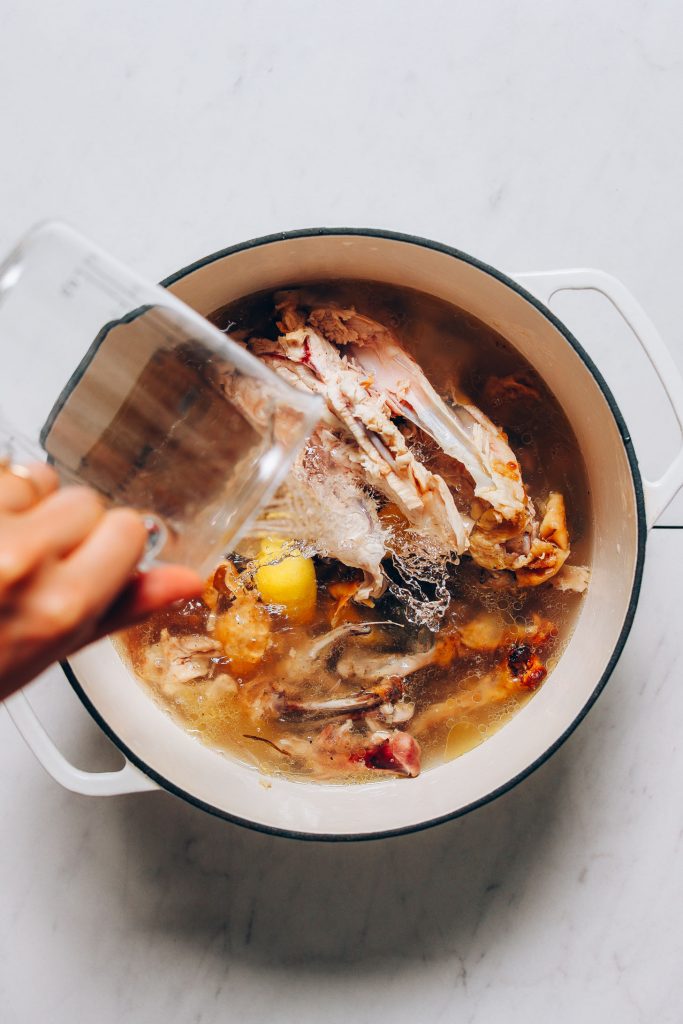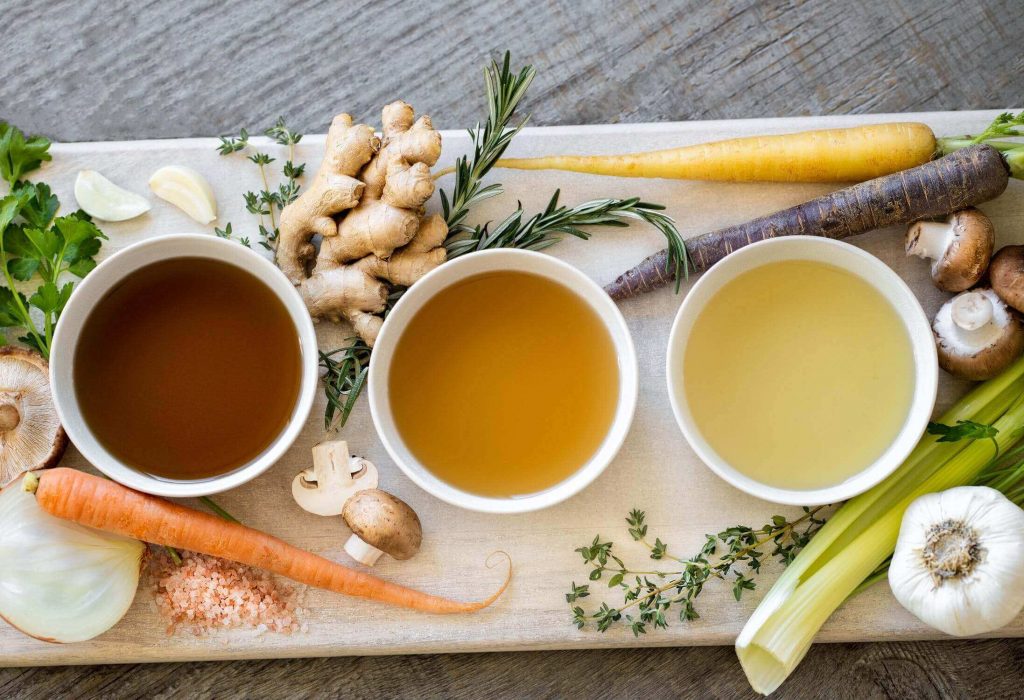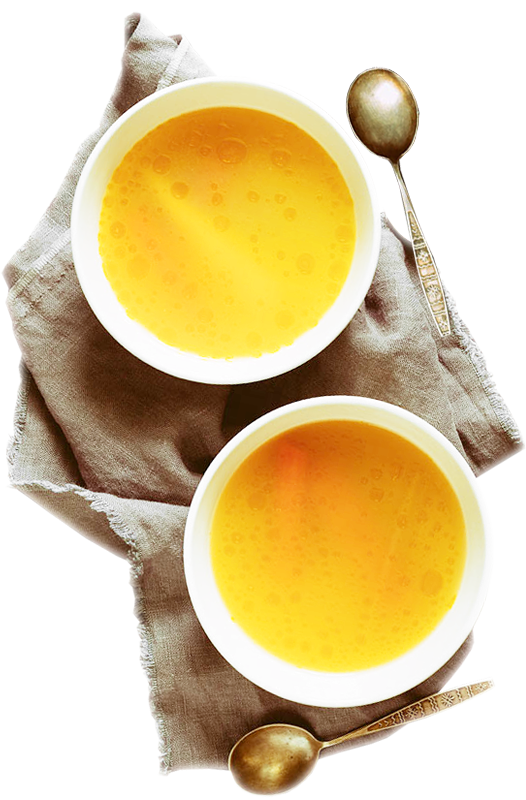The bones are used in the preparation of chicken stock the majority of the time, whereas the meat of the chicken is used in the preparation of chicken broth the majority of the time. When bones are allowed to boil for an extended amount of time, gelatin is produced, and as a result, the chicken stock that is produced as a result has a mouthfeel that is normally more substantial, as well as a flavor that is typically more robust. When time is of the essence, the best friend of a home cook is chicken broth from a can that has been seasoned with less sodium. If you have a few minutes to spare, you can improve the flavor of the dish by adding any combination of the following ingredients and stewing it for as long as you can: carrots, leeks, onions, celery, parsley, fennel, bay leaf, black peppercorns, or garlic. If you have a few minutes to spare, you can improve the flavor of the dish by adding any combination of the following ingredients. If you have some spare time, you can enhance the flavor of the dish by including any combination of the following components: The flavor will be noticeably altered as a result of this change.
Even though enhancing store-bought broth won’t provide you with the full-stock experience, it is a fantastic time saver if you’re creating something that doesn’t require a stocky mouth feel, such as chicken noodle soup, for which you do want the stocky mouth feel. In other words, it’s a great time saver if you’re not making anything that requires a stocky mouth feel. My opinion is that those who cook their own meals at home ought to be aware of the distinction between the 2 when it comes up in conversation. In order to extract all of the flavors from the meats and vegetables that are going to be used to produce the broth, the items are first given a long, slow simmer in water. Take a look at our beef bone broth that was prepared with beef from Melbourne.
The Difference Between Chicken Stock And Chicken Broth
We have a confession to make: after trying to conduct an unofficial poll around the place of work and beyond, we found that some of us (we won’t name names), who love to cook, were not one hundred percent clear on the distinction among chicken stock and broth. This is something that we are not proud of, but it is the truth. However, we are not going to name names at this time. We were aware that one of the variants was far heartier than the other, but which one it was and why remained a mystery (at least to some of us). Cooks who have more experience in the kitchen and chefs who work professionally often use the terms broth and stock interchangeably. Who else can we go to for direction if we can’t count on them to provide it?! In light of this, if we take chicken stock and compare it to chicken broth, what would you say are the key differences between the two? How are they put together in the first place? Which one should you make use of when, and when should you make sure to steer clear of the other one? We will provide replies to these vital questions, as well as the processes for generating chicken broth and stock, as well as some straightforward recipes, and more informative material.
Let’s start with the basics and investigate the similarities and differences between these two distinct kinds of cooking liquids. Both stock and broth refer to the liquid that is formed when animal parts and vegetables are cooked for an extended period of time in the water, and then the liquid is strained to remove all of the solid particles that were left behind in the cooking process. Both stock and broth have the potential to serve as the basis for a wide variety of different soups, stews, gravies, and sauces. Rice, risotto, orzo, or pretty much any other grain or pasta that you desire to create can have an additional layer of flavor added to it by substituting stock or broth for the water in the cooking process. Because a broth will cheerfully use the tops of carrots, the bottoms of celery, and the outer layers of onions, all of which are typically thrown away, they are also a manner of reducing the quantity of food that is wasted in the home. Or a compost bin, if you’re more into that kind of stuff than most people. Nevertheless, what would you say are the most significant differences between stock and broth?
What Is Chicken Stock?
Chicken stock is produced when the chicken carcass, particularly the bones, is cooked for an extended period of time. This is by far the most important step in the process. Everything may be reduced to its bare bones. During the prolonged process of simmering the bones in water, collagen, a necessary protein, is removed from the bones. This process also results in the production of a layer of fat on the surface of the liquid, which is then filtered when the liquid has cooled. That is yours to retain and hold on to. After being heated, the gelatinous layer will melt back into the sauce, bringing with it a flavor that is rich, earthy, and full of umami. It is the one that springs to mind first whenever we are asked to think of a “heartier” option. In spite of the fact that it packs a more powerful punch of flavor, a stock often does not have any salt or spices added to it, at least not in considerable proportions. It ensures that the stock is flavorless and can be used in a wide variety of contexts thanks to its adaptability. Even though we recommend preparing your own chicken stock whenever possible, you can get canned and bagged chicken stocks at any grocery or convenience store. You’ll find them in the aisle with the other canned foods. There are numerous well-known brands available, some of which are Kitchen Basics, Pacific, and College Inn. College Inn, get it? Collagen.
What Is Chicken Broth?
The cooking liquid known as chicken broth is produced by simmering the carcass, skin, and sometimes the bird’s meat with veggies in water and seasoning it with salt, herbs, and spices. The end result of this process is the creation of the broth. There are many different dishes that call for the usage of chicken broth. Even though the soup is on the lighter side, it has a flavor that is rich and deep enough that it can be sipped and savored on its own. Even though the broth is on the bright side, it has a flavor that rich and deep enough that it can. In addition, there is a wide variety of preparation techniques for vegetarian broth. If you don’t feel like making your own broth or simply lack the time to do so, you may buy pre-made broth in the store. It comes in cans or cartons and can be found on the food aisle. We strongly suggest shopping for a low-sodium variety so that you can season it with any amount of salt you like.
If you just want to tell the difference between chicken stock and broth by looking at them, the stock will often be cloudier and darker than the broth will be. This is how you can tell the difference between the two (from the collagen). The stock is often dirtier, heavier, and more concentrated than the broth, which is typically cleaner and less concentrated.
Benefits Of Chicken Broth
The cooking liquid known as chicken broth is produced by simmering the carcass, skin, and sometimes the bird’s meat with veggies in water and seasoning it with salt, herbs, and spices. The end result of this process is the creation of the broth. There are many different dishes that call for the usage of chicken broth. Even though the soup is on the lighter side, it has a flavor that is rich and deep enough that it can be sipped and savored on its own. Even though the broth is on the bright side, it has a flavor that rich and deep enough that it can. In addition, there is a wide variety of preparation techniques for vegetarian broth. If you don’t feel like making your own broth or simply lack the time to do so, you may buy pre-made broth in the store. It comes in cans or cartons and can be found on the food aisle. We strongly suggest shopping for a low-sodium variety so that you can season it with any amount of salt you like.
If you just want to tell the difference between chicken stock and broth by looking at them, the stock will often be cloudier and darker than the broth will be. This is how you can tell the difference between the two (from the collagen). The stock is often dirtier, heavier, and more concentrated than the broth, which is typically cleaner and less concentrated.
The chicken bone broth that you consume can provide you with a number of critical nutrients, some of which are listed below:
- Calcium
- Magnesium
- Iron
- Glutamine
- Phosphorus
- Gelatin
- Glycine
- Collagen
- Protein
- Potassium
- Glucosamine
- Chondroitin sulfate
Improves Digestion
The health of the digestive tract can be improved by drinking chicken broth since it contains glutamine. The intestinal lining can once again become impermeable after being repaired by glutamine, which plays a part in the process of repairing perforations in the lining of the gut. This will not only make digestion easier but will also help enhance your immune system.
Protects Your Joints
Regularly ingesting or drinking chicken broth can assist support joint pain, a common result of aging that can be exacerbated with time. This is because chicken broth contains collagen and gelatin that are produced naturally by the chicken.
Gelatin has been shown to be effective in reducing the pressure that is exerted on the joints. Including it in your diet is a fantastic idea due to the fact that in addition to providing a cushioning effect, it may also fill the space that is left between bones.
Clears Skin
Collagen is one of the most vital nutrients for preserving the suppleness of the skin, and one of the best sources of collagen can be found in chicken broth. Chicken broth is a good source of collagen. It is the primary structural protein in your skin and the component that is responsible for giving your skin the impression of being full, firm, and youthful. On the other hand, the symptoms of premature aging, such as fine lines and wrinkles, appear when collagen begins to disintegrate as a result of either the normal process of aging or exposure to environmental toxins. This can happen either as a result of natural aging or as a result of exposure.
Zinc is a mineral that can be found in the human skeleton in rather high concentrations. The treatment of acne and the upkeep of healthy skin both require this as a vital ingredient. The action of the bacteria found on the skin known as P. acnes, which is responsible for the development of acne, can be inhibited by zinc, as the findings of one study have shown.
The chicken broth contains glycosaminoglycans, which are generally found in the dermis, and elastin in the skin. These molecules, together with collagen and zinc, are found in the chicken broth. They serve the purpose of filling the space between collagen and elastin, which contributes to the preservation of the skin’s fullness and pliability.
Improves Sleep
The element magnesium, which may be found in chicken broth, is well-known for the calming impact it has. It is required for around 300 distinct enzymatic processes that occur within the body, some of which include the production of proteins, the transfer of nerve signals, and the muscle relaxation process. There is a potential that an improvement in sleep quality will be brought about by each of these functions. Here at Bone Broth, we have compiled a detailed list of the numerous benefits that can be reaped by consuming bone broth.
When magnesium is taken in the form of a meal rather than as a supplement, it is able to be absorbed by the body in the most efficient manner possible.
Healthy Immune System
The production of chicken broth results in the production of amino acids, which aid improve digestion and decrease inflammation in the respiratory system, respectively, according to the findings of a number of studies. Additionally, it is possible that these molecules have a therapeutic effect on illnesses such as asthma and allergies.
Nutrition
Making your own chicken broth is not that difficult, and doing so provides you with more control over the ingredients. The convenience of ready-to-go chicken broth from the store makes it an appealing buy, despite the fact that it often contains a high amount of sodium. On the other hand, a broth with a lower salt concentration is often provided.
The nutritional value of chicken broth produced at home may shift depending on the ingredients that are added to it. On the other hand, you might be able to obtain a recipe that includes the nutritional information that you need so that you can use it as a reference. In general, chicken broth that has been made from scratch should include just a moderate amount of both calories and sodium.
You may get an idea of how many nutrients are contained in your homemade chicken broth by looking at the nutrition information that are stated on a box of chicken broth that is already ready for consumption and is ready to be consumed. The following components can be found in a cup of chicken broth that has already been prepared for consumption:
- 15 calories
- 0.5 grams of fat in total
- 2 grams of protein per serving
- 1 gram of carbohydrate
- there is 5 mg of cholesterol in total
The United States Department of Agriculture (USDA) reports that consuming chicken broth that has been prepared for consumption does not provide a significant supply of any wellness nutrient other than riboflavin, which accounts for 11 percent of the daily value. Other than riboflavin, no other health-promoting nutrients are found in chicken broth. The broth does include a little amount of the vitamins and minerals calcium, copper, vitamin B12, magnesium, zinc, potassium, iron, selenium, niacin, and vitamin E; however, these are only present in trace amounts.
It’s possible that one of the reasons drinking chicken broth makes you feel so much better is because of its long history of use as a treatment for a variety of illnesses. Therefore, you can discover that eating this type of food makes you feel the greatest when you’re not feeling well.
Step By Step Guide To The Best Ever Homemade Chicken Broth Recipe
A recipe for homemade chicken broth is the only item that can take a dish to a new level of deliciousness. A store-bought version may be handy, but only a recipe for homemade chicken broth can do this. It doesn’t matter if you’re planning on impressing your dinner guests with a hearty winter stew, a fulfilling fall soup, or a mouthwatering risotto since you can prepare all three! Because of the robust flavor it imparts, homemade chicken broth can transform even the most mundane of dishes into something spectacular. It is unfortunate that it can be tough to find a recipe that does not look to be very complicated to make. However, you are in luck since we are here to help you out with that. Here at Bone Broth, we have compiled an extensive assortment of the most mouthwatering bone broth recipes in the industry.
If you want to create your own chicken broth at home, what are some of the benefits of doing so? To begin, making your own chicken broth from scratch provides you the entire control over the ingredients that go into it, which means that you can be positive that you are getting exactly what you want out of it. This allows you to be more flexible in your cooking. When you buy your broth from the supermarket, it is not going to be easy to keep track of how many salt and other chemicals are included in it. On the other hand, when you prepare your own broth, you have complete control over the quantity of salt that goes into it (and, if you so choose, you may also derive nutritional benefits from a greater range of veggies). In addition, we take advantage of the fact that our homemade chicken broth may be frozen and kept for a period of up to three months in the freezer.
Gather Your Ingredients
You’ll need the following ingredients: one small chicken weighing between 2.25 and 3 pounds, one large onion weighing 8 ounces that have been quartered (it’s fine to leave the skin on), two medium carrots weighing 4 ounces that have been trimmed, and cut into large chunks, two stalks of celery weighing 4 ounces that have been trimmed and cut into large chunks, one clove of garlic, six peppercorns, and one bay leaf.
Add Water
Cover the chicken with ice water and place it in a large pot that is more on the thin and tall side than the short and wide side (about 8 cups). Make sure the chicken you are cooking fits into a saucepan that is at least a couple of inches higher than the chicken. It makes it possible for the water to move about the ingredients and extract the maximum amount of flavor from them. It will also make it much easier to remove anything and everything that floats to the top and can be skimmed off. This will make the process much more efficient.
Simmer And Skim
Over a low heat setting, bring the water to a gentle boil. During the time that the liquid is simmering, take out and dispose of anything that rises to the top of the liquid. Simmer for thirty min.
Add Veggies
Continue to simmer the mixture for an additional hour and a half after you have added the onion, carrots, and celery.
Make A Bouquet Garni
The following steps need to be taken in order to prepare the bouquet garni, which is commonly referred to as a bundle of herbs wrapped in cheesecloth. Parsley, thyme, garlic, peppercorns, and a bay leaf should be arranged on top of a square of cheesecloth that has been folded over twice. A piece of yarn can be used to both conceal and fasten the item.

It is akin to adding a teabag to your stock; it will help infuse the flavor of the spices into the broth while was still simple to remove from the stock. Adding this will be similar to putting a teabag in your stock.
Add The Bouquet Garni
After placing the bouquet garni in the saucepan, reduce the heat to a simmer and cook the chicken for thirty to forty-five minutes, or until it is very tender and the broth has taken on a great deal of flavor (adding the herb package too early can cause the flavors to cook away completely or become dull).
Remove Veggies
After the chicken and vegetables have been moved to a large bowl, the stock should have salt added to it after it has been simmered. Next, shred the flesh, set aside the skin and bones, and set the shredded meat aside for use in another meal or recipe.
Strain The Stock
The broth should be transferred to a colander that has been lined with cheesecloth that has been rinsed, and then the colander should be placed over some other saucepan or measuring cup. Any more scraps that are dropped into the broth will be collected as a result of this action.
Jar And Refrigerate
The broth can be stored in the fridge for up to 5 days or in the freezer for up to 3 months if it is placed in jars or containers first.


